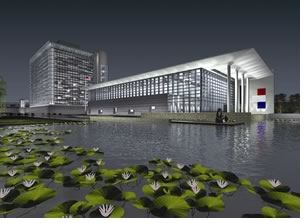

Preparations for Overseas Practice
 by
Paul V. Riccardi
by
Paul V. Riccardi
To practice overseas, U.S. design firms need to do their homework and evaluate the differing cultural and legal aspects of doing practice in the market they wish to enter.
Toward that end, the AIA International Committee, in cooperation with the AIA New York Chapter and AIA New York International Committee, hosted a panel of industry experts October 2 to discuss “International Practice Issues: Cross-Cultural Partnerships.” Held at the Center for Architecture, the conference gave designers access to colleagues with significant first-hand experience working on built projects overseas as well as insurance and licensing experts.
Setting out the issues
Marilyn Jordan Taylor, FAIA, urban design partner and former chair of
Skidmore, Owings & Merrill LLP, began the program by stressing the
nature of intersecting cultures in international practice. For the
practice of architecture to be truly global, Taylor stated, “firms
must practice across cultures by maintaining a commitment to openness
and difference.”
Taylor also pointed to the importance of watching carefully the growth of the world’s mega-cities (cities with populations of more than 10 million). Experts predict there will be 36 mega-cities by 2015, she said, up from the current 23. Design needs to adapt to the extraordinary pace of change in these cities to maximize the value and capacity of the cities’ infrastructure, which first requires an understanding of the country’s culture and practices, she said.
 Educating the firm globally
Educating the firm globally
Before learning about a new culture, principals should first consider
their firm’s goals and how well they match the countries under
consideration. For instance, how much demand is there for the firm’s
project-type experience? The next step is to find a client, either
a local client or a U.S. client, with business in that particular country.
According to Steven M. Davis, FAIA, of Davis Brody Bond, there are
several ways for a firm to find a foreign client:
- Look for a client through research and marketing
- Establish a strategic alliance
- Enter local design competitions
- Bring your own client, or have one bring you.
The key is to find a reliable partner. Talk to past consultants of a client to see how smoothly (or not) their projects unfolded with the same client. Once a client relationship is established, firms need to:
- Determine how business is conducted locally
- Determine what kind of documentation is required
- Investigate what methods and materials are available
- Understand the culture and environment well enough so that the design makes sense within the local context.
It is also a good idea to have the relevant language skills on board so you can be assured of accurate communications on a professional level. Along with the appropriate research, this will help projects proceed more smoothly. Investigation of local market conditions and capabilities will determine if projects can be constructed as intended, which will help to manage client expectations. Each culture has its own set of do’s and don’ts, and these expectations need to be managed carefully. As with all projects, careful development of a budget and schedule is also critical.
 Practicing overseas
Practicing overseas
Firms attempting to expand overseas also need to consider local licensing
laws. Many countries have title laws, which means design professionals
not licensed in those countries can still practice as long as they
do not use the term architecture or engineering to describe their services.
Practice laws, alternatively, allow design professionals to call themselves
architects or engineers, even though they cannot legally practice either
discipline without licensure.
In addition, there are two main types of agreements used in international practice.
- Practice in a Host Nation Agreement: Design professionals practice in conjunction with a local design professional who takes responsibility for the project.
- Full Mutual Recognition Agreement: Design professionals become licensed in a foreign country and receive full recognition as such.
While not inclusive, these issues are critical for design firms to address prior to practicing internationally.
The business side of international practice
Dick Viktora, Esq., SOM general counsel, and Joseph H. Jones Jr., Esq.,
AIA, managing director of risk management services for Schinnerer,
discussed issues involving the professional services contract, general
business practices, and professional liability insurance.
Contracts
- Clearly define the role of the design professional. Is that role legally permissible in the host country?
- Try to use standard contract forms whenever possible. Client-generated agreements are usually heavily biased toward the client.
- Be sure to include a choice of law provision—negotiate the U.S. as the choice of law jurisdiction.
- Carefully define the scope of services—disputes over this are the most common claims triggers with overseas projects.
- Get your contract in writing.
- Negotiate an arbitration provision.
Business Practices
- Consult with qualified advisors on legal and accounting issues.
- Research local practices on code compliance, contract formation, and negotiation.
- Research the legal system—how are disputes resolved?
Insurance
- Make sure your professional liability policy provides coverage for overseas work.
- Determine how your insurer handles overseas claims.
- Be aware of exclusions to your policy.
- Look for uninsurable provisions, e.g., warranties or guarantees.
- Negotiate a contractual time limitation for project-related claims.
Copyright 2004 Victor O. Schinnerer & Co. Reprinted with permission.
Copyright 2004 The American Institute of Architects.
All rights reserved. Home Page ![]()
![]()
 |
||
| Paul Riccardi
is editor of risk management publications with Victor O. Schinnerer & Co.,
Inc.
U.S. Embassy in Beijng by SOM, currently under construction. (Drawing courtesy of the architect.) Valeo Electrical Systems, San Luis Potosi, Mexico, by Davis Brody Bond, a 2002 Business Week/Architectural Record Award winner. (Photo ©Jaime Navarro.)
|
||